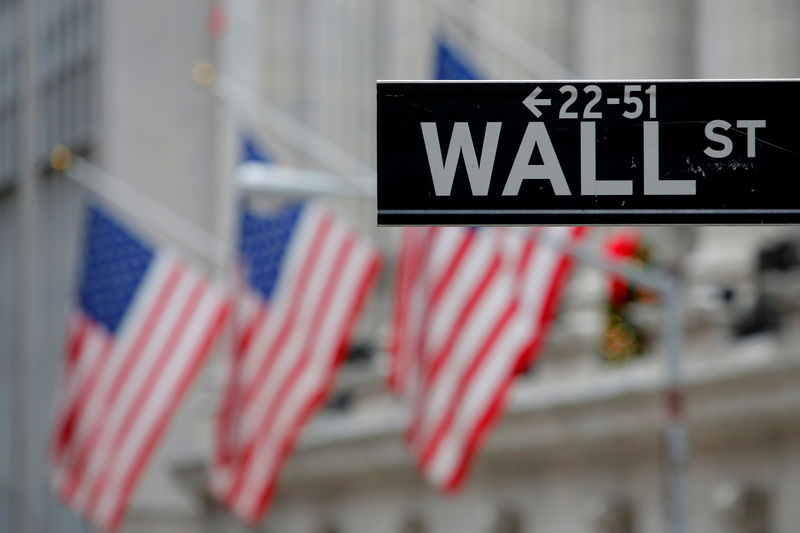 © Reuters. FILE PHOTO: A street sign for Wall Street is seen outside the New York Stock Exchange in Manhattan, New York City
© Reuters. FILE PHOTO: A street sign for Wall Street is seen outside the New York Stock Exchange in Manhattan, New York CityBy Mark Miller
CHICAGO (Reuters) – (The opinions expressed here are those of the author, a columnist for Reuters.)
One of the biggest trends in retirement saving over the past decade has been the shift to target date funds – broadly diversified mutual fund products that automatically adjust the blend of stocks and bonds as your retirement date approaches. The idea is to reduce the risk of big losses as your expected retirement age gets close.
Considering the sharp market downturn in 2018, how is that working out?
I asked Morningstar to analyze the six most popular target date funds (TDFs) dated for 2020 – the closest fit for people about to retire. In a year when the was down 4.38 percent (on a total return basis, which includes dividends), three of the top six TDFs did a bit better than the market, while the other three performed slightly worse. But all of them were down.
Do the results mean TDFs are not doing their job? Not at all. Rather, they reflect differing investment philosophies among the fund management companies about the blend of stocks and bonds appropriate for investors close to retirement. But the results underscore that it is critical for TDF investors to understand what these funds are meant to do – and what they are not.
“It’s important to remember that TDFs are not a guarantee of positive return over the short-term,” said Jeff Holt, director of multi-asset and alternative strategies at Morningstar. “The most important part for a retirement investor is to really understand what they are getting – that they are handing over their assets to a fund manager who creates a diversified portfolio for them.”
TDFs have grown rapidly in recent years, and more than half of 401(k) participants use them, according to the Investment Company Institute. The typical TDF invests in domestic and international equities, large and small companies and a range of fixed-income offerings. That diversification has value for the typical retirement investor, especially as the TDF fees have fallen. Morningstar reports that the average asset-weighted expense ratio for these funds fell to 0.66 percent at the end of 2017 (the most recent year of available data), down from 0.91 percent five years earlier.
But TDFs do not protect against market basics. Stocks will have good and bad years – and 2018 was bad for most asset classes. Global stocks were down 14.20 percent ( Morgan Stanley (NYSE:) Capital International All Country World Index Ex-U.S.); small-cap equities were down 10 percent (Russell 2500 TR USD) and it was a weak year for bonds, too. The only strong category was domestic large cap stocks – that aforementioned 4.38 percent drop in the S&P 500 Index actually was a relative bright spot.
Market volatility poses important risks for people starting to draw down funds at the time of a big drop, especially in the first five years of retirement. Retirement researchers call this “sequence of return risk.”
The biggest losses to lifetime retirement income hit when markets perform poorly early in retirement – the loss of all the compound earnings after that point really takes a toll. “If it happens within seven years of your retirement, it can be very tough to recover,” said Dirk Cotton, founder of JDC Planning. “If you’re outside that range, sequence of returns risk diminishes with time.”
CLOSER LOOK AT THE TOP SIX
Among the funds Morningstar analyzed, differing investment philosophies explain the varying 2018 performance last year. Here they are, ranked from worst to best performance compared with the S&P 500 last year, with brief comments from the fund companies:
JPMorgan (NYSE:) SmartRetirement 2020 R6JP (-5.30 percent) weights its TDF more heavily than most to international developed and emerging market equities, and extended fixed income, such as high yield and emerging market debt.
Fidelity Freedom 2020 K (-5.16 percent) uses a more aggressive glide path; while some funds reach their most conservative allocation on the target date, the Fidelity fund does so 19 years after the target date.
T. Rowe Price Retirement 2020 (-4.82 percent) underperformed last year due to its market-cap and geographic diversification within equities. “In addition to large-cap equities, the fund also invests in small- and mid-cap stocks as well as international equities, among others,” a spokesman said. “Small-, mid-cap, and international equities all underperformed large-cap equities during the year.”
Vanguard Institutional Target (NYSE:) Retirement 2020 Fund (-4.21 percent): The Vanguard fund also has a very large fixed-income position – about 47 percent of the total portfolio, and 40 percent of its equity exposure is outside the United States.
BlackRock LifePath Index 2020 K (-3.96 percent): Blackrock (NYSE:) takes a more risk-averse approach close to the target date, with its largest allocation to high quality fixed income.
Capital Group’s American Funds 2020 Target Date Retirement R6 (-2.69 percent): During the quarter, the fund’s emphasis on dividend paying equities provided downside resilience; it also had less exposure to global stocks than its fund peers.
Of course, what is up this year could be down next year. Said Cotton: “The issue isn’t really whether your portfolio will earn an average 8 percent a year over time, but when the bad years will occur.
(Reporting and writing by Mark Miller in Chicago; Editing by Matthew Lewis)
Source: Investing.com




























